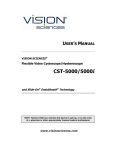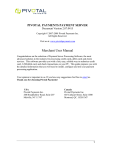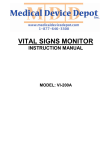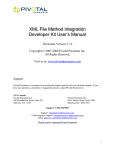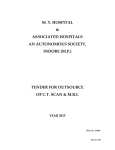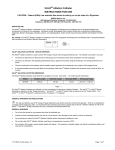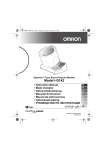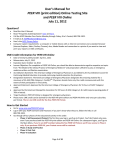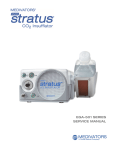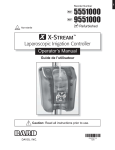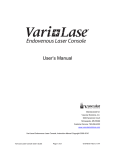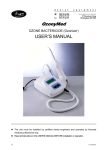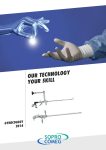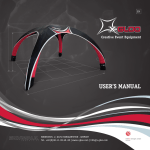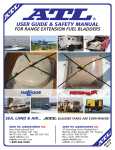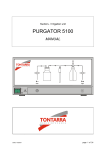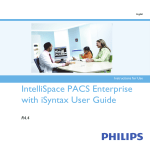Download COLON INSUFFLATOR REF 6400 Operator`s
Transcript
COLON INSUFFLATOR REF 6400 Operator’s Manual 0086 Rx Only (USA) TABLE OF CONTENTS SECTION 1.0 UNPACKING AND GENERAL INSPECTION ………………………………… 3 SECTION 2.0 INTRODUCTION..…………………………………………………………………...4 2.1 INDICATION AND CONTRAINDICATIONS....................................................................... 4 2.2 SAFETY FEATURES ................................................................................................................ 4 SECTION 3.0 INSUFFLATOR THEORY OF OPERATION........................................................ 5 SECTION 4.0 WARNINGS AND CAUTIONS................................................................................. 6 4.1 WARNINGS ................................................................................................................................ 6 4.2 CAUTIONS ................................................................................................................................. 7 SECTION 5.0 DESCRIPTION OF EQUIPMENT........................................................................... 8 5.1 SPECIFICATIONS .................................................................................................................... 8 5.2 ELECTRICAL REQUIREMENTS .......................................................................................... 8 5.3 UL EQUIPMENT CLASSIFICATION .................................................................................... 9 5.4 ENVIRONMENTAL REQUIREMENTS ................................................................................ 9 SECTION 6.0 FRONT PANEL CONTROLS................................................................................. 10 SECTION 7.0 REAR PANEL CONTROLS ................................................................................... 12 SECTION 8.0 HIGH PRESSURE HOSE AND YOKE ASSEMBLY .......................................... 13 SECTION 9.0 ASSEMBLY PRIOR TO COLON INSUFFLATION ........................................... 14 9.1 INSUFFLATOR PREPARATION.......................................................................................... 14 9.2 ELECTRICAL CONNECTIONS ........................................................................................... 14 9.3 CO2 HOSE CONNECTIONS .................................................................................................. 15 SECTION 10.0 SETTING-UP AND PERFORMING THE PROCEDURE .................................. 17 10.1 POWER ON AND GAS SUPPLY INDICATOR................................................................... 17 10.2 PREPARATION TEST ............................................................................................................ 17 10.3 SETTING PATIENT PRESSURE .......................................................................................... 18 10.4 RESET CO2 VOLUME ............................................................................................................ 18 10.5 PATIENT CONNECTION FOR INSUFFLATION.............................................................. 18 10.6 ADMINISTRATION SET CONNECTION FOR INITIAL INSUFFLATION.................. 18 10.7 PATIENT INSUFFLATION.................................................................................................... 19 10.8 OBSERVATIONS DURING INSUFFLATION .................................................................... 19 10.9 CO2 VOLUME DISPLAY........................................................................................................ 21 10.10 TERMINATING GAS FLOW & SHUT-DOWN PROCEDURES ..................................... 21 SECTION 11.0 DECONTAMINATION, CLEANING AND STORAGE...................................... 22 SECTION 12.0 REPAIR .................................................................................................................... 23 12.1 CUSTOMER SOLUTIONS AND ORDERING INFORMATION...................................... 23 12.2 WARRANTY............................................................................................................................. 23 12.3 CERTIFICATION OF NON-CONTAMINATION .............................................................. 24 SECTION 13.0 CERTIFICATE OF NON-CONTAMINATION ................................................... 25 SECTION 14.0 TROUBLESHOOTING GUIDE ............................................................................. 26 SECTION 15.0 EMC TABLES........................................................................................................... 35 PROTOCO2LTM Colon Insufflator User Manual Page 2 Section 1.0 UNPACKING AND GENERAL INSPECTION CAUTION: READ ALL SECTIONS OF THIS MANUAL CAREFULLY BEFORE USING PROTOCO2L™ COLON INSUFFLATOR, SUCH THAT OPERATION IS UNDERSTOOD. IF YOU SHOULD HAVE ANY QUESTIONS, PLEASE CONTACT E-Z-EM, INC. CUSTOMER SOLUTIONS AT 1-800-544-4624, 516-333-8230 OR YOUR LOCAL E-Z-EM, INC. REPRESENTATIVE. Proper care and maintenance are critical for safe operation of sophisticated medical equipment. We recommend careful inspection of all equipment upon receipt and prior to each use as a safeguard against possible injury to patient or operator. To avoid inadvertent damage, study this manual thoroughly before handling, assembling, testing, using, or cleaning the PROTOCO2L™ Colon Insufflator. Examine the shipping carton and instrument for signs of damage. Any breakage or other apparent damage should be noted, the evidence retained, and the carrier or shipping agency notified. Verify that the shipping carton contains the items listed below: PROTOCO2L™ Colon Insufflator Operator’s Manual Quick Reference Guide Power Cord (see CAUTION below) High Pressure Hose & Yoke Notify E-Z-EM, Inc. Customer Solutions immediately if any damage or discrepancies are noted. Phone: 1-800-544-4624 (USA), 1-516-333-8230 CAUTION: The line cord (mains lead) supplied with this unit is designed and approved for use in the USA and Canada only, and should not be used outside these countries. For use outside of the USA and Canada, your Distributor will supply a line cord that is approved for use in your country. Page 3 PROTOCO2LTM Colon Insufflator User Manual Section 2.0 INTRODUCTION This manual provides information for the operation of the PROTOCO2L™ Colon Insufflator, (also referred to in this manual as "unit" or "device"). DEFINITIONS The following list is abbreviations of commonly used terms throughout this manual: LPM Liter Per Minute (or Liters Per Minute) mm Hg millimeters of mercury gas CO2 2.1 INDICATION AND CONTRAINDICATIONS Indications for Use: The PROTOCO2L™ Colon Insufflator administers and regulates carbon dioxide as a distention media to the colon during CT Colonography (CTC or Virtual Colonoscopy) and conventional Colonoscopy. Contraindications for Use: The PROTOCO2L™ Colon Insufflator should be used only when colon insufflation is indicated, and should therefore not be used for any other treatments. It should only be used under the direct guidance of a physician experienced in colon insufflation. This device is contraindicated for hysteroscopic insufflation, i.e., it must not be used for intrauterine distention. This product should not be used in patients with known or suspected colonic perforation or toxic megacolon, It should not be used within 6 days of large forceps or “hot” biopsy, or snare polypectomy. Do not use this product in a colostomy stoma. Do not use this product following recent rectal surgery or low rectal anastomosis, or when proctitis or other rectal conditions such as inflammatory or neoplastic diseases are suspected. 2.2 SAFETY FEATURES The following features help to ensure safe operation of the machine: FLOW STOP/RUN button: Upon turning power on, gas flow is not initiated until the FLOW STOP/RUN button is pressed. The electrical pressure relief will occur when 50 mm Hg is reached and sustained for 5 seconds. An audible alarm will sound during actuation of the electronic pressure relief at 50 mm Hg. Additionally, the PRESSURE display will flash. A fixed mechanical pressure relief occurs at 75 mm Hg. An audible alarm will sound when the CO2 gas supply tank pressure is low. Additionally, the Gas Supply Indicator bar graph display will flash. PROTOCO2LTM Colon Insufflator User Manual Page 4 Section 3.0 INSUFFLATOR THEORY OF OPERATION The PROTOCO2L™ Colon Insufflator operates by administering CO2 at a maximum flow rate of 3 LPM, and then monitoring the current colonic pressure. A value for colonic pressure is selected by the operator, turning the Pressure Adjust Dial on the front panel. Once started, the colonic pressure will gradually increase and will be displayed on the Pressure Display on the front panel. The flow of CO2 will gradually decrease when the current pressure approaches the user determined value (on the Pressure Adjust Dial). The colonic pressure has stabilized when the pressure shown on the Pressure Display equals the pressure set on the Pressure Adjust Dial and the flow of CO2 will stop. While in the RUN mode, the PROTOCO2L™ Colon Insufflator will maintain the selected colonic pressure by continuously monitoring the current colonic pressure and will compensate for a loss in the colonic pressure by allowing additional CO2 to flow until the current pressure is equal again to the user determined colonic pressure setting. The PROTOCO2L™ Colon Insufflator has an electronically controlled Pressure Relief Valve at 50 mm Hg and an independent redundant mechanical Pressure Relief Valve pre-set to 75 mm Hg. Both pressure relief safety devices are active whether the Gas Flow is on or off. Page 5 PROTOCO2LTM Colon Insufflator User Manual Section 4.0 WARNINGS AND CAUTIONS This section describes warning and caution information for safe operation of the PROTOCO2L™ Colon Insufflator. All information in this manual, and particularly in this section, should be read thoroughly and understood before using the device. 4.1 WARNINGS If pneumoperitoneum (free intra-peritoneal air) is observed, or if colonic perforation is suspected at any time during the use of PROTOCO2L insufflator, immediately discontinue use and provide appropriate medical treatment. Prior to use, be sure to read all instructions for use on the PROTOCO2L Administration Set. Excessive absorption of CO2 results from either excessive flow rate and/or excessive pressure. The colon can be adequately distended by pressure in the range of 15 to 25 mm Hg. Use of pressure less than or equal to 25 mm Hg will dramatically reduce the likelihood of intravasation of CO2 gas into open vascular channels. Also, adequate respiration helps avoid problems related to CO2. Should accidental intravasion of CO2 occur, in rare circumstances, it can result in embolization. Infusion of CO2 can result in carbonic acid irritation to directly contacted tissues. Use only USP “Medical Grade” CO2 available in “D/E” supply tanks Equipment is not suitable for use in the presence of a flammable anesthetic mixture with air, oxygen, or nitrous oxide. Never attempt to service the device when it is connected to a power source. Hazardous voltages inside the device can cause severe electrical shock. Disconnect the power cord before servicing. Ensure that all high-pressure gas line connections are secure before opening the gas source(s). Loose connections could separate unexpectedly with great force, causing personal injury. This device should be operated only by or under the direct supervision of a licensed physician experienced in colon insufflation. The user should be thoroughly familiar with the operation of this device prior to use. Additionally, individuals using this device must be alert and attentive to the operation of the system while it is connected to the patient. Diligence on the part of the operator is an essential requirement of overall device safety. To avoid the risk of electrical shock, connect the power cord to a properly wired grounding receptacle only. To prevent unit contamination and patient cross-contamination, use only E-Z-EM’s PROTOCO2L™ Administration Set which includes a 0.1 micron hydrophobic filter. Idiosyncratic reactions: In patients with sickle cell disease or pulmonary insufficiency, use of these devices may pose increased risks of metabolic imbalance related to excessive CO2 absorption. PROTOCO2LTM Colon Insufflator User Manual Page 6 Always instruct the patient to immediately notify the operator of any pain experienced during the procedure. If an emergency should arise whereby the need to terminate insufflation is required, operators should stop the gas flow by promptly disconnecting the PROTOCO2L™ Administration Set at the Insufflator Output Port. The PROTOCO2L™ Colon Insufflator can release CO2 to the surrounding atmosphere in the event of misuse or a fault condition. Use and store the PROTOCO2L™ Colon Insufflator in a well ventilated environment. Additionally, make sure all CO2 supply tank connections are correctly installed and free of visible damage. Should an unexplained rapid discharge of CO2 occur, evacuate the immediate area until it has had sufficient time to ventilate. High Pressure USP CO2 is supplied to the PROTOCO2L™ Colon Insufflator from commercially available CO2 supply tanks. Please read and carefully follow all Warnings, Cautions and Handling Instructions provided with, and listed on these CO2 supply tanks that are used with the PROTOCO2L™ Colon Insufflator. Failure to do so can result in Serious Injury or Death. This product contains phthalates which have been perceived as having possible carcinogenic, mutagenic and reproductive risks. However, based on all existing scientific data, the long history of safe use of medical device products containing phthalates, as well as the short duration of contact with this device, there are no known cancer or reproductive risks to humans. Physician discretion is required to ensure that benefits outweigh risks when this device is used in children, elderly and pregnant women. 4.2 CAUTIONS Page 7 Do not allow fluids to enter the device. The cabinet should not be opened except by a qualified service person. Tampering by unqualified persons can damage the unit and void the warranty. Verify proper connection of tubing before using the unit. This device has not been tested for MR compatibility, and should not be introduced into the MR exam room. Do Not attempt to use this system until you have completed all the steps in “Assembly Prior to Colon Insufflation” Section 9.0 and “Setting-Up for the Procedure” Section 10.0. If the equipment differs significantly in appearance or operation from the way it is presented in this manual, or you have any doubts whatso-ever concerning its installation or operation, inform E-Z-EM, Inc. Customer Solutions at 1-800-544-4624 (USA), 1-516-333-8230. PROTOCO2LTM Colon Insufflator User Manual Section 5.0 DESCRIPTION OF EQUIPMENT The PROTOCO2L™ Colon Insufflator is indicated for use as a means of providing colonic distention. 5.1 SPECIFICATIONS Size: 10” wide x 5.50” high x 10” deep. 254 mm x 140 mm x 254 mm Weight: Less than 20 lb. (9.0 kg) Control Panel: Push-buttons and rotary dial. Digital pressure and volume readouts. Gas Flow: 0 to 3 LPM Pressure Adjustment: 0 to 25 mm Hg operating. Pressure Relief Valve: Electronic controlled relief of pressure at 50 mm Hg for 5 seconds. Fixed mechanical pressure relief at 75 mm Hg. Both reliefs are active whether gas flow is on or off for added protection. Audible alarm will sound at the time of actuation of the electronic pressure relief at 50 mm Hg. Operating modes: FLOW STOP/RUN Gas Inlet: Single “D/E” CO2 supply tank. WARNING: Do not allow liquid CO2 to enter the unit. This can be prevented by assuring that the CO2 supply tank is maintained in a vertical position at all times. Gas Input Pressure: 75 to 2200 PSI, flow to 25 PSI. Patient Set: Available for use with 0.1 micron hydrophobic filter. E-Z-EM, Inc. supplies an Administration Set that includes this filter. 5.2 ELECTRICAL REQUIREMENTS Input Voltage: 100 to 240 VAC nominal line voltage; 50/60 Hz. (line voltage can vary by ±10% from nominal) Power: 25 watts, double fusing with removable power cord Standards: UL-2601-1; IEC-601-1; IEC-601-1-2; EN55011; EN60601-1-2; EN50082-1; EN61000-4-2-3-4-5-6-8-11, EN61000-3-2-3. PROTOCO2LTM Colon Insufflator User Manual Page 8 5.3 UL EQUIPMENT CLASSIFICATION Underwriter’s Laboratories/CSA Class I Type B 5.4 ENVIRONMENTAL REQUIREMENTS Operating Temperature: 50° to 104° F (10° to 40° C) Operating Relative Humidity: 30 to 70% non-condensing Operating Pressure: 700 to 1060 hPa 20.7 to 31.3 (inches of Mercury) Storage Temperature: 32° to 160° F (0° to 70° C) Storage Relative Humidity: 20 to 90% non-condensing Storage Pressure: 500 to 1060 hPa 14.8 to 31.3 (inches of Mercury) Not to be used in the presence of flammable gases. NOTE: This unit has not been tested for MR compatibility and should not be introduced into the MR exam room. Page 9 PROTOCO2LTM Colon Insufflator User Manual Section 6.0 FRONT PANEL CONTROLS NOTE: The appearance of your PROTOCO2L™ Colon Insufflator may differ slightly from the units shown in the illustrations and photographs. (Example: buttons may be round or square). [1] GAS SUPPLY INDICATOR Three colors of LED’s to indicate the relative amount of gas available in a "D/E" CO2 supply tank. [2] VOLUME LITERS DISPLAY Indicates the total amount of gas used. [3] VOLUME RESET Clears the volume display to zero. [4] FLOW STOP/RUN Depression starts flow. Unit will flow at 1 to 3 LPM based on volume delivered. Flow is incrementally delivered during first Liter: delivery volume from 0 to 0.5 Liter at 1 LPM maximum, delivery volume greater than 0.5 to 1 Liter at 2 LPM maximum and delivery volume greater than 1 Liter at 3 LPM. Upon pressing the FLOW STOP/RUN button at the start of the procedure, the unit will remain in run mode until 4 Liters of CO2 have been delivered. Once 4 Liters have been delivered, the unit automatically returns to stop mode. Thereafter pressing the FLOW STOP/RUN button a second time will resume the delivery of CO2 for an additional 2 Liters of CO2. Once an additional 2 Liters have been delivered, the unit automatically returns to stop mode. Subsequent presses of the FLOW STOP/RUN button will deliver additional 2 Liter boluses of CO2 as required by the user. The user can always depress the STOP/RUN button during any of these volume increments to stop delivery of CO2. PROTOCO2LTM Colon Insufflator User Manual Page 10 NOTE: Flow cannot be initiated if gas bottle pressure is less than 25 PSI. [5] PRESSURE ADJUST AND DISPLAY 270° rotary control. Dial shows pressure set point. Allows the user to select between 0 to 25 mm Hg. Display shows pressure. [6] GAS OUTPUT CONNECTION TO PATIENT Connector for patient tubing set. [7] POWER SWITCH Turns the power on and off to the machine. Page 11 PROTOCO2LTM Colon Insufflator User Manual Section 7.0 REAR PANEL CONTROLS [8] GAS INPUT PORT For connecting a “D/E” supply tank using the High Pressure Hose and Yoke assembly provided. WARNING: Do not allow liquid CO2 to enter the unit. This can be prevented by assuring that the CO2 supply tank is maintained in a vertical position at all times. [9] AC POWER CONNECTION Universal AC line input device – nominal AC line voltage 100 to 240 VAC frequency 50/60 Hz. The AC line voltage should not drop below 90 VAC or exceed 264 VAC. There are no switches or other AC line configuration requirements. The line cord (mains lead) supplied with this unit is designed and approved for use in the USA and Canada only, and should not be used outside these countries. For use outside of the USA and Canada, your Distributor will supply a line cord that is approved for use in your country. AC input is with a standard hospital grade power cord. Connection should be to hospital grade receptacles only. PROTOCO2LTM Colon Insufflator User Manual Page 12 Section 8.0 HIGH PRESSURE HOSE AND YOKE ASSEMBLY The assembly consists of the YOKE as shown in Figure 8.1 and the HIGH PRESSURE HOSE as shown in Figure 8.2. Figure 8.1 NOTE: Before proceeding to the next step, check for the presence of the plastic gasket on the inside of the yoke (arrow on Figure 8.1). Figure 8.2 Page 13 PROTOCO2LTM Colon Insufflator User Manual Section 9.0 ASSEMBLY PRIOR TO COLON INSUFFLATION IMPORTANT If at any time the unit performs erratically or provides otherwise abnormal operation, remove the unit from service and have it inspected or repaired. The PROTOCO2L™ Colon Insufflator should be inspected upon receipt and before each use. Damaged equipment should be removed from service and returned to E-Z-EM, Inc. for repair or replacement. Before each use, perform the procedures and inspections described in Sections 9.1, 9.2 and 9.3 9.1 INSUFFLATOR PREPARATION 1. Install the PROTOCO2L™ Colon Insufflator on the Accessory Cart, or on a flat surface, away from potential sources of spraying or leaking liquids. 2. Visually inspect the PROTOCO2L™ Colon Insufflator for external signs of damage. 9.2 ELECTRICAL CONNECTIONS 1. Inspect the electrical connections. Do not use if inspection reveals any damage. 2. Connect the Power Cord to the AC Power Connection on the back of the PROTOCO2L™ Colon Insufflator. 3. Before connecting the power cord to the hospital grade wall outlet, make sure that the main power switch is off and that the voltage is correct. The PROTOCO2L™ Colon Insufflator has a universal AC line input device, the nominal AC line voltage is 100 to 240 VAC and the AC line frequency is 50/60 Hz. The AC line voltage should not drop below 90 VAC or exceed 264 VAC. There are no switches or other AC line configuration requirements. PROTOCO2LTM Colon Insufflator User Manual Page 14 9.3 CO2 HOSE CONNECTIONS 1. If not already connected, assemble the High Pressure Hose and Yoke using a 9/16″ open-end wrench on the hose fitting and a ¾″ Open Ended wrench on the Yoke’s hexagonal shaped surface. The complete Hose-Yoke assembly is shown in Figure 9.1. Identify the post valve Yoke positioning holes on the CO2 supply tank (Tank not provided with system), as shown in Figure 9.2. Figure 9.1 Figure 9.2 2. Slide the Hose-Yoke assembly over the top of the post valve and align the two positioning pins from the Yoke with the two locating holes from the CO2 supply tank post valve. Insert the pins into the locating holes and tighten the Yoke on the post valve with the T-handle provided with the Yoke. Place the valve wrench included with cart (see Figure 9.3), or equivalent open-end/adjustable wrench, on the valve stem as shown in Figure 9.4 Figure 9.3 Figure 9.4 3. Remove cap from the CO2 Input port on back of Insufflator. Tighten the other end of the High-Pressure Hose to the CO2 Input port on the back of the Unit using a 9/16″ open-ended wrench (see Figure 9.5). Figure 9.5 Page 15 NOTE: Do not use any teflon tape or thread sealing compounds on any connection. PROTOCO2LTM Colon Insufflator User Manual WARNING: Do not allow liquid CO2 to enter the unit. This can be prevented by assuring that the CO2 supply tank is maintained in a vertical upright position at all times. USE ONLY MEDICAL GRADE CO2 SIZE “D” OR “E” supply tanks. Before each use the following procedures or inspections should be performed: Visually inspect the PROTOCO2L™ Colon Insufflator for external signs of damage. Inspect the electrical connections. Do not use if inspection reveals damage. Before connecting the power cord to the wall outlet, make sure the main power switch is off and that the voltage is correct. Inspect the connection to the CO2 supply tank, to assure it is intact and tight. NOTE: To assure maximum life of CO2 supply tank, always close CO2 tank from the post valve when not in use. PROTOCO2LTM Colon Insufflator User Manual Page 16 Section 10.0 SETTING-UP AND PERFORMING THE PROCEDURE 10.1 POWER ON AND GAS SUPPLY INDICATOR 1. Open the valve on the CO2 supply tank approximately 1 turn. Turn on the Power Switch. Upon turn on, all lights and indicators will be illuminated for a brief period. 2. The Gas Supply indicator should display red-yellow-green bars. The color coding in the bar graph is a guide to determine whether there is sufficient gas in a “D/E” CO2 supply tank to finish a procedure, as indicated below: Lights Green Yellow Red Available CO2 Gas Tank Pressure is greater than 175 PSI. Tank Pressure is 75 to 175 PSI. Tank Pressure is less than 75 PSI. Change Tank! NOTE: If CO2 supply tank pressure is less than 25 PSI (red), flow cannot be initiated. 10.2 PREPARATION TEST There is always the possibility that delicate equipment can be damaged in transportation or storage. Therefore it is important to verify proper operation of the unit before use. 1. After power is applied to the unit, verify that the front panel lights are enabled. NOTE: If the output pressure is negative or in an alarm state, the Pressure Display will indicate the actual pressure. 2. To verify that flow control is functioning properly, depress the FLOW STOP/RUN button. When pressed, the light in the switch should light, and gas may be heard exiting from the unit. If gas does not begin flowing, verify that the CO2 supply tank valve is in the open position (see Power On and Gas Supply Indicator, #1, above). 3. To verify that the Pressure Adjust and Display are functioning properly, block off the Output connector, and rotate the Pressure select dial through the entire range of 0 to 25 mm Hg. Verify a pressure increase on the Pressure Display. 4. When the FLOW RUN/STOP button is pressed initially, 4 Liters of CO2 are delivered and the unit automatically returns to STOP mode. Thereafter, subsequent presses of the FLOW STOP/RUN button will resume the delivery of CO2 for an additional 2 Liters before automatically returning to STOP mode. However, you can stop the flow using the FLOW STOP/RUN button while the unit is in RUN mode, as evidenced by the illuminated FLOW STOP /RUN button. 5. If the unit does not perform properly, do not use. Inspect the unit using the Troubleshooting guide (Section 14.0) before returning for service. Page 17 PROTOCO2LTM Colon Insufflator User Manual 10.3 SETTING PATIENT PRESSURE To set patient pressure, rotate the Pressure Select dial to the desired pre-set pressure. Once flow has been initiated, the pressure display will indicate the current pressure value. An initial insufflation pressure of 20 mm Hg is recommended. If necessary, the pressure may be increased up to 25 mm Hg during the procedure to obtain adequate distention. 10.4 RESET CO2 VOLUME Assure that the Volume Display reads zero prior to beginning insufflation. To reset the Volume Liters Display, press the Volume Reset. NOTE: Do not press Volume Reset button once procedure has started. 10.5 PATIENT CONNECTION FOR INSUFFLATION Place the patient in the lateral decubitus position, and insert the Administration Set into the patient, following the instructions included with the Administration Set. It is important to use only E-Z-EM, Inc. manufactured high flow tubing with a 0.1 micron hydrophobic filter to prevent cross contamination of the patient or PROTOCO2L™ Colon Insufflator. E-Z-EM, Inc. manufactures an Administration Set (that includes the filter) designed to provide optimum insufflator performance. It is recommended that this Administration Set be used. Always inspect every Administration Set to make sure there are no signs of damage. If such a condition exists, do not use the Administration Set. See Administration Set instructions for use. The use of unauthorized administration sets may cause damage of your insufflator, and result in voiding your warranty. 10.6 ADMINISTRATION SET CONNECTION FOR INITIAL INSUFFLATION Insert the connector on the Administration Set to the Gas Output connection on the insufflator’s Front panel. PROTOCO2LTM Colon Insufflator User Manual Page 18 10.7 PATIENT INSUFFLATION 1. Begin insufflation in the lateral decubitus position by pressing the FLOW STOP/RUN button to initiate gas flow. Gently roll the patient into the supine position. Allow the pressure and volume to stabilize. 2. Within approximately 1 to 3 minutes, the volume will stabilize between 2 and 3 L, and the pressure will stabilize at the set-point. If after 3 to 5 minutes, the actual volume stabilizes at less than 2 Liters, the pressure remains less than the set-point, or the volume fails to stabilize, see OBSERVATIONS DURING INSUFFLATION below. Note: If the volume reaches 4 Liters at any point during the procedure, the flow of CO2 will automatically pause. This will be evident by the light on the FLOW STOP/RUN button going out. Pressing the FLOW STOP/RUN button again will reinitiate the flow for an additional 2 Liters. Each subsequent restarting of the flow will reinstate the flow for an additional 2 Liters. 3. Take the scout image. Evaluate the quality of insufflation. If insufflation is insufficient, see OBSERVATIONS DURING INSUFFLATION below. 4. Begin supine CT scan. 5. Following the supine scan, roll the patient to the prone position. Immediately take the scout image. 6. Begin prone CT scan. 10.8 OBSERVATIONS DURING INSUFFLATION 1. Patient Discomfort: Occasionally, the patient may feel some abdominal discomfort during the initial stages of insufflation, which is primarily due to the distention of the colon. To minimize patient discomfort, the following steps may be taken: a. Instruct the patient to breathe through his/her mouth. b. Instruct the patient to relax his/her abdominal muscles during the procedure. c. If the unit is in RUN mode, the flow of CO2 may be paused by pressing the FLOW STOP/RUN button to allow time for the colon to relax. Once the patient is comfortable, the flow can be re-started by pressing the FLOW STOP/RUN button again. d. For patients who require more gradual insufflation, the pressure of CO2 may be lowered (15 to 20 mm Hg) by using the Pressure Adjust Dial, to allow for a more gradual distention of the colon. When the patient is comfortable, the pressure should be slowly raised to 20-25 mm Hg. Page 19 PROTOCO2LTM Colon Insufflator User Manual 2. Insufficient Distention: It is not uncommon for some colonic segments to appear inadequately distended in either the prone or supine positions. In particular, inadequate distention of the transverse colon may occur in heavier patients in the prone position. To improve distention: a. Check to make sure that the flow of CO2 has not paused (i.e. that the FLOW STOP/RUN button is illuminated). b. Check the Administration Set tubing for kinks, closed clamps, excessive colonic fluid, or anything that could block the flow of CO2 into the patient. c. Remind the patient to breathe orally. d. Instruct the patient to relax his/her abdominal muscles. e. It may be necessary, particularly for the heavier patient, to use pillows or foam positioning blocks underneath a patient’s sternum and/or pelvis to improve colonic distention while in the prone position. By elevating these portions of a patient’s anatomy, the abdominal cavity should distend more freely and redistribute the patient’s weight on the CT table. f. If necessary, additional CO2 (up to 2 Liters) may be added by pressing the FLOW STOP/RUN button. 3. Lower than expected volume of CO2 : A stabilized volume of less than 2 Liters of CO2 in the initial scanning position is generally an indication of incomplete distention of one or more colonic segments. If this occurs, perform the following steps: a. Roll the patient onto either side to redistribute the CO2 in the colon. b. Raise the pressure to 25 mm Hg. c. A drop in the pressure as indicated on the pressure display on the front panel will indicate the opening of the segment in question, and will be accompanied by an increase in the volume of CO2. d. Continue with the rolling maneuver until the volume reaches at least 2 Liters. 4. Higher than expected volume of CO2: If the volume pauses at 4 Liters, one of the following conditions may be present. A scout image should be taken immediately to evaluate. a. Pneumoperitoneum – If free intra-peritoneal air is observed, or if colonic perforation is suspected, immediately discontinue insufflation by disconnecting the administration set from the insufflator. Provide appropriate medical attention. b. Small bowel reflux – If reflux is evident and distention is acceptable, proceed with study. If additional CO2 is required, it may be added by depressing the FLOW STOP/RUN button, under the supervision of a physician. If small bowel reflux is observed, completing the study as quickly as possible will help to minimize the reflux. c. Leakage around rectal tube – If the colon is not fully distended, and no small bowel reflux is evident, it may be due to leakage around the rectal tube. If not already inflated, the physician should consider inflating the rectal balloon on the rectal tube. In addition, ask the patient to squeeze his/her muscles to retain the rectal tube. If additional CO2 is required, it may be added by depressing the FLOW STOP/RUN button. PROTOCO2LTM Colon Insufflator User Manual Page 20 NOTE: If an emergency should arise whereby there is a need to terminate insufflation, the operator should stop the CO2 gas flow by promptly disconnecting the Administration Set at the PROTOCO2L™ Colon Insufflator Output port. 10.9 CO2 VOLUME DISPLAY The Digital Volume Display reads the total volume of CO2 passing from the PROTOCO2L™ Colon Insufflator to the patient. The digital display indicates the volume of CO2 delivered in Liters and tenths of Liters and has a range of 0 to 99.9 Liters. NOTE: While in the RUN mode, the unit will maintain the set pressure in the colon even if there is no apparent flow. The unit must be left on until the procedure is completed. 10.10 TERMINATING GAS FLOW & SHUT-DOWN PROCEDURES 1. Upon completion of the diagnostic procedure, disconnect PROTOCO2L™ Administration Set from the unit at the Output port and press the FLOW STOP/RUN button if in RUN mode. Allow colon to deflate through the PROTOCO2L™ Administration Set. 2. Deflate retention cuff, clamp administration set to prevent spillage of colonic fluids and remove tip. Discard the entire PROTOCO2L™ Administration Set in accordance with all Federal, State and Local regulations. Administration Sets are intended for single-use only. Reuse of the administration set carries an increased risk of cross-contamination. 3. Turn power off and disconnect the power cord from power outlet. 4. It is recommended that the CO2 supply tank valve be fully closed when not in use. Page 21 PROTOCO2LTM Colon Insufflator User Manual Section 11.0 DECONTAMINATION, CLEANING AND STORAGE Prior to disinfecting the PROTOCO2L™ Colon Insufflator, ensure the power is turned off and the electrical cord is unplugged. To disinfect the PROTOCO2L™ Colon Insufflator wipe down with an intermediate-level disinfectant (corrosive disinfectants, such as bleach, are not recommended since they may damage the equipment) in accordance with the manufacturer’s directions. Do not use abrasive or sharp-edged devices when disinfecting the PROTOCO2L™ Colon Insufflator. Do not allow fluids to enter the unit. Dry all components thoroughly. Do not sterilize or autoclave this unit. For general cleaning, the PROTOCO2L™ Colon Insufflator can be wiped down with a damp cloth and mild soap. The E-Z-EM, Inc. PROTOCO2L™ Colon Insufflator should be covered and stored in a cool dry location. Care should be taken to avoid rough handling, jarring, or dropping the unit. PROTOCO2LTM Colon Insufflator User Manual Page 22 Section 12.0 REPAIR There are no user adjustments inside the PROTOCO2L™ Colon Insufflator cabinet. Repairs and adjustments are to be performed only by E-Z-EM, Inc. or authorized service or repair facilities. Unauthorized service, repair, or modifications to the PROTOCO2L™ Colon Insufflator will void your warranty. As with any precision instrument, periodic calibration of the unit on an annual basis is recommended, or on a more frequent basis if conditions require. *If repairs become necessary call E-Z-EM, Inc. prior to returning the device, and request return authorization. Warranty repairs will be made without charge. All other repairs will be made on a time and material basis. If requested, E-Z-EM, Inc. will provide an estimate of the repair cost and the time for the repair before any work is done. For customers within the US, repair items, (including power cord, Yoke and High Pressure Hose) should be carefully repackaged and returned, post paid, to: E-Z-EM, Inc. Suite 126 532 Broadhollow Road Melville, NY 11747 For customers outside of the US, please call Customer Service for instructions on returning your unit for service. *PRODUCTS MAY NOT BE RETURNED TO E-Z-EM, INC. WITHOUT PRE-APPROVAL. 12.1 CUSTOMER SOLUTIONS AND ORDERING INFORMATION Phone: 1-800-544-4624 (USA), 1-516-333-8230 12.2 WARRANTY Your new PROTOCO2L Colon Insufflator is warrantied against all defects in materials and workmanship for 12 months from the date of purchase. This warranty shall not apply to any PROTOCO2L Colon Insufflator which: Page 23 Has been repaired by anyone other than an authorized E-Z-EM, Inc. representative Has been altered in any way so as to, in the judgment of E-Z-EM, Inc. affect its function. Has been subject to misuse, negligence, or accident, including damage caused by contact with patient effluent or other substances. PROTOCO2LTM Colon Insufflator User Manual This warranty does not cover routine cosmetic wear and tear on the system, including scratching and marring of this device. This warranty is in lieu of all other warranties, expressed or implied, including without limitation any implied warranty of merchantability or fitness for a particular use, and of all other obligations or liabilities on the part of E-Z-EM, Inc. There are no warranties that extend beyond the description on the face hereof. 12.3 CERTIFICATION OF NON-CONTAMINATION All products being returned to E-Z-EM, Inc. must be accompanied by a Certificate of Non-Contamination. Products that have become contaminated in any way shall not be returned to E-Z-EM, Inc., unless special written permission has been granted by E-Z-EM, Inc. Otherwise, a Certificate of Non-Contamination shall be provided with returned products that have been reportedly decontaminated. In other special cases certification of Proper Handling for Bio-Hazardous Material must be sent to E-Z-EM, Inc. for pre-approval before such material can be returned. PROTOCO2LTM Colon Insufflator User Manual Page 24 Section 13.0 CERTIFICATE OF NON-CONTAMINATION Customer Name: Address: City: State: Zip Code: Contact Name: Authorized Signature: Telephone # and E-mail: Product Model No.: Description: SERIAL No.: RA. No.: The above person hereby certifies that the above described product being returned to E-Z-EM, Inc., has been inspected and contains no foreign material or fluids and is not contaminated with any bio-hazardous matter or any other material that may cause or contribute to any illness or personal injury of any kind. Prior to disinfecting the PROTOCO2L™ Colon Insufflator, ensure the power is turned off and the electrical cord is unplugged. To disinfect the PROTOCO2L™ Colon Insufflator wipe down with an intermediate-level disinfectant (corrosive disinfectants, such as bleach, are not recommended since they may damage the equipment) in accordance with the manufacturer’s directions. Do not use abrasive or sharp-edged devices when disinfecting the PROTOCO2L™ Colon Insufflator. Do not allow fluids to enter the unit. Dry all components thoroughly. Do not sterilize or autoclave this unit. Prior to returning any product to E-Z-EM, Inc. complete this Certificate of Non-Contamination Form, and send/fax to E-Z-EM, Inc. Quality department at 1-631-847-3904 Page 25 PROTOCO2LTM Colon Insufflator User Manual Section 14.0 TROUBLESHOOTING GUIDE Make sure that you have read and understand the prior sections of this operator’s manual that provide normal operating instructions for your PROTOCO2L™ Colon Insufflator, including the warnings and cautions section. Before making arrangements with E-Z-EM, Inc. Customer Solutions to send your PROTOCO2L™ Colon Insufflator unit back to the factory for service, we ask that you take a few minutes to review the following information in this guide while simultaneously examining your unit. Please be advised that the appearance of your PROTOCO2L™ Colon Insufflator may differ slightly from the units shown in the following photographs. (Example: buttons may be round or square). The Field Checkout steps listed here pertain to common operating conditions and possible malfunctions. Review this information and refer to it when communicating with your E-Z-EM, Inc. Customer Solutions Representative. This will enable us to identify the best course of action to meet your service needs. Should you need further assistance with this guide, see your supervisor, or contact E-Z-EM, Inc., Customer Solutions at 1-800-544-4624 (USA), 1-516-333-8230. Condition Possible Causes Field Checkout My PROTOCO2L™ Colon Insufflator does not Power-up at all. No power at wall outlet Check PROTOCO2L™ Colon Insufflator in wall outlet known to be operational. What should I do? Blown fuse Remove power cord from rear panel of PROTOCO2L™ Colon Insufflator and use a small screwdriver to open fuse holder. Pull fuse holder down and examine fuses. If blown, replace with 0.5-Amp 250-Volt Time-Delay Fuses. PROTOCO2LTM Colon Insufflator User Manual Page 26 Condition Possible Causes Field Checkout My PROTOCO2L™ Colon Insufflator does not Powerup at all. Front panel rocker switch “off” With unit plugged into wall outlet, activate Power Switch to the ON or (1) position. What should I do? Upon completing its Power-up sequence, the front panel should appear as follows: Power Switch The power switch should be illuminated with the VOLUME LITERS and PRESSURE displays both Indicating “0”. Additionally, the GAS SUPPLY Indicator should also be illuminated and indicate the current amount of CO2 in the supply tank. The above display indicates that the unit has correctly Powered-up. Should the unit continue to fail to Power-up, or if the front panel does not appear as shown above after Power-up, you will need to contact E-Z-EM, Inc. Customer Solutions. Page 27 PROTOCO2LTM Colon Insufflator User Manual Condition Possible Causes Field Checkout My PROTOCO2L™ Colon Insufflator does not deliver CO2. Empty CO2 supply tank or valve closed After successfully Powering-up your PROTOCO2L™ Colon Insufflator, examine the GAS SUPPLY Indicator on the front panel. What could be the problem? Make sure that the tank Valve for the CO2 supply tank is open. Your PROTOCO2L™ Colon Insufflator should sense the pressure from the CO2 supply tank and the GAS SUPPLY Indicator should illuminate as follows: 3 red, 4 yellow and 3 green. If during Power-up or operation of the PROTOCO2L™ Colon Insufflator, the CO2 in the supply tank is depleted, the illuminated GAS SUPPLY Indicator segments extinguish themselves from the full reading. Once the GAS SUPPLY Indicator shows 3 red segments, the unit will periodically beep and no longer deliver CO2. Additionally the 3 red segments will also blink. If this occurs, reconnect the PROTOCO2L™ Colon Insufflator to a full CO2 supply tank to continue operation. Should the PROTOCO2L™ Colon Insufflator’s CO2 Supply display fail to indicate full after verifying the CO2 supply tank is full and the tank valve is open, you will need to contact E-Z-EM, Inc. Customer Solutions. PROTOCO2LTM Colon Insufflator User Manual Page 28 Condition Possible Causes Field Checkout My PROTOCO2L™ Colon Insufflator does not deliver CO2. PROTOCO2L™ Colon Insufflator flow rate incorrect To check the PROTOCO2L™ Colon Insufflator’s ability to deliver CO2 to the patient, follow these verification steps: What could be the problem? After Powering-up and making sure that your PROTOCO2L™ Colon Insufflator is connected to the CO2 supply tank, depress the VOLUME RESET button, zero will appear in the VOLUME LITERS display. Rotate the Pressure Adjustment Dial to 25 mm Hg. Disconnect the Administration Set if connected. Press the FLOW STOP/RUN button to start. Using a wrist watch with a second hand or a stop watch, allow the unit to deliver 4.0 liters of CO2. The unit should reach this volume and automatically return to stop between 90 and 120 seconds. During this time interval, place your finger near the Gas OUTPUT. You should feel gentle pulses of CO2 exiting from the PROTOCO2L™ Colon Insufflator. Page 29 PROTOCO2LTM Colon Insufflator User Manual Condition Possible Causes Field Checkout “CONTINUED” My PROTOCO2L™ Colon Insufflator does not deliver CO2. PROTOCO2L™ Colon Insufflator flow rate incorrect What could be the problem? At start-up, your PROTOCO2L™ Colon Insufflator should normally deliver the flow of CO2 to the patient incrementally as follows: 1 LPM for 0 to 0.5 Liters of delivered volume, 2 LPM for greater than 0.5 to 1 Liter of delivered volume and a maximum of 3 LPM for delivered volumes greater than 1 Liter. This procedure verifies this performance parameter. If you are unable to successfully replicate these steps, contact E-Z-EM, Inc. Customer Solutions or check the routing of patient Administration Set to make sure that it is not kinked, occluded or leaking. PROTOCO2LTM Colon Insufflator User Manual Page 30 Condition Possible Causes Field Checkout My PROTOCO2L™ Colon Insufflator is not distending the colon enough. PROTOCO2L™ Colon Insufflator delivery pressure incorrect. To Check the PROTOCO2L™ Colon Insufflator’s ability to deliver CO2 at a set pressure please follow these verification steps: What could be the problem? Attach an Administration Set to the Gas OUTPUT of your PROTOCO2L™ Colon Insufflator. Engage the tubing clamp at the distal end of the Administration Set. Using the Pressure Adjustment Dial, set the delivery pressure to 25 mm Hg. Press the FLOW STOP/RUN button to start the delivery of CO2. As the flow of CO2 starts, the Effluent Trap belonging to the Administration Set should start to inflate. Additionally, the PRESSURE Display should start to increase. Once the Effluent Trap is full, the PRESSURE displayed by the PROTOCO2L™ Colon Insufflator should reach approximately 35 to 45 mm Hg. Page 31 PROTOCO2LTM Colon Insufflator User Manual Condition Possible Causes Field Checkout PROTOCO2L™ Colon Insufflator delivery pressure incorrect. With the pressure holding steady between 35 to 45 mm Hg, place the inflated Effluent Trap in your hand as shown. While in this position, use your thumb to gently squeeze it flat. “CONTINUED” My PROTOCO2L™ Colon Insufflator is not distending the colon enough. What could be the problem? As the Effluent Trap is squeezed, the pressure on the display will rise. Maintain a uniform pressure on the Effluent Trap such that the pressure displayed remains between 55 and 65 mm Hg for 5 seconds. At the end of the 5 second time, an audible click should be heard from the unit and the CO2 in the Effluent Trap should freely vent from the system. During venting, the PRESSURE display should blink and the unit should beep. Remove finger pressure from the Effluent Trap. Verify reinflation to 35 to 45 mm Hg. Your PROTOCO2L™ Colon Insufflator should also vent in accordance with the checkout steps prescribed above. If you are unable to replicate unit operation as prescribed here contact E-Z-EM, Inc. Customer Solutions. Depending upon the particular patient and clinical set-up, it may be necessary to use pillows or foam positioning blocks underneath a patient’s sternum and/or pelvis to improve colonic distention while in the prone position. By elevating these portions of a patient’s anatomy, the abdominal cavity should distend more freely and redistribute the patient’s weight on the CT table. PROTOCO2LTM Colon Insufflator User Manual Page 32 Condition Possible Causes Field Checkout My CO2 supply Tank is prematurely emptying. Valve on CO2 supply tank left open all of the time. We recommend attaching your PROTOCO2L™ Colon Insufflator accessory to either “D” or “E” size CO2 supply tank. Be sure to close the CO2 supply tank valve whenever the unit is not in use. What could be the problem? The pneumatic design of the PROTOCO2L™ Colon Insufflator is not intended to provide a full time gas seal from the CO2 supply tank while the device is not being used or in storage. Should the CO2 supply tank valve inadvertently be left open, there is a high likelihood that the CO2 supply tank contents will gradually empty over several days. High Pressure Hose from CO2 supply tank is not installed properly If after opening and closing the CO2 supply tank valve with your procedure schedule, you still encounter problems with CO2 supply tank prematurely emptying, there is the possibility that the High Pressure Hose from the CO2 supply tank to the PROTOCO2L™ Colon Insufflator unit is leaking. Please inspect the High Pressure Hose in accordance with the following procedure: Using an adjustable or Open Ended ¾" wrench, detach the High Pressure Hose from PROTOCO2L™ Colon Insufflator’s rear panel. Inspect the tapered surface of the free standing nipple on the PROTOCO2L™ Colon Insufflator and the interior of the High Pressure Hose. This is the sealing surface. Verify that it is free of any debris or contaminant. Also, verify that the surface is smooth and free of any nicks or distortion. Taper Taper Repeat this inspection procedure at the identical tapered gas connection at the CO2 supply tank valve Yoke. Page 33 PROTOCO2LTM Colon Insufflator User Manual Condition Possible Causes Field Checkout High Pressure Hose from CO2 supply tank is not installed properly Inspect the CO2 supply tank Yoke and verify that the plastic disc that creates the gas seal at the CO2 supply tank valve is in-place and free from defect. “CONTINUED” My CO2 supply Tank is prematurely emptying. What could be the problem? Disc After verifying all High Pressure Hose sealing surfaces are clean and free of defect; reconnect the High Pressure Hose to the CO2 supply tank Yoke and PROTOCO2L™ Colon Insufflator. Use an adjustable or Opened Ended ¾" wrench to tighten securely. DO NOT USE ANY TEFLON TAPE OR THREAD SEALING COMPOUNDS. Reconnect the Yoke to the CO2 supply tank valve making sure that the plastic sealing disk is in place. Open the CO2 supply tank valve. If CO2 continues to prematurely empty or should you hear CO2 escaping from any of these connections or the High Pressure Hose itself, contact E-Z-EM, Inc. Customer Solutions. PROTOCO2LTM Colon Insufflator User Manual Page 34 Section 15.0 EMC TABLES The PROTOCO2L™ Colon Insufflator has been tested by Underwriters Laboratory to the following electro-magnetic compatibility standards: Table 1 Guidance and manufacturer’s declaration – electromagnetic emissions The PROTOCO2L Colon Insufflator is intended for use in the electromagnetic environment specified below. The customer or the user of the PROTOCO 2L Colon Insufflator should assure that it is used in such an environment. Emissions Test Compliance CISPR 11 RF Emissions Group 1 CISPR 11 RF Emissions Class A IEC 61000-3-2 Harmonic Emissions Class A IEC 61000-3-3 Voltage fluctuations / flicker emissions Page 35 Electromagnetic environment - guidance The Colon Insufflator uses RF energy only for its internal function. Therefore, its RF emissions are very low and are not likely to cause any interference in nearby electronic equipment. Complies PROTOCO2LTM Colon Insufflator User Manual Table 2 Guidance and manufacturer’s declaration – electromagnetic immunity The PROTOCO2L Colon Insufflator is intended for use in the electromagnetic environment specified below. The customer or the user of the PROTOCO2L Colon Insufflator should assure that it is used in such an environment. IEC 60601 test level Immunity Test IEC 61000-4-2 Electrostatic discharge (ESD) IEC 61000-4-4 Electrical fast transient burst IEC 61000-4-5 Surge IEC 61000-4-11 Voltage dips, short interruptions and voltage variations on power supply input lines IEC 61000-4-8 Power frequency (50/60 Hz) magnetic field Compliance level Electromagnetic environment – guidance +/-6 KV contact +/-6 KV contact +/-8 KV air +/-8 KV air Floors should be wood, concrete or ceramic tile. If floors are covered with synthetic material, the relative humidity should be at least 30 %. +/-2 KV for power supply lines +/-2 KV for power supply lines Mains power quality should be that of a typical commercial or hospital environment. +/-1 KV for input/output lines +/-1 KV for input/output lines +/-1 KV differential mode +/-1 KV differential mode +/-2 KV common mode +/-2 KV common mode <5 % Ut (>95 % dip in Ut) for 0.5 cycle <5 % Ut (>95 % dip in Ut) for 0.5 cycle 40 % Ut (60 % dip in Ut) for 5 cycles 40 % Ut (60 % dip in Ut) for 5 cycles 70 % Ut (30% dip in Ut) for 25 cycles 70 % Ut (30% dip in Ut) for 25 cycles <5 % Ut (>95 % dip in Ut) for 5 sec <5 % Ut (>95 % dip in Ut) for 5 sec 3 A/m 3 A/m Mains power quality should be that of a typical commercial or hospital environment. Mains power quality should be that of a typical commercial or hospital environment. If the user of the PROTOCO2L Colon Insufflator requires continued operation during power mains interruptions, it is recommended that the PROTOCO2L Colon Insufflator be powered from an uninterruptible power supply or battery. Power frequency magnetic fields should be at levels characteristic of a typical location in a typical commercial or hospital environment. Note: Ut is the A.C. mains voltage prior to application of the test level. PROTOCO2LTM Colon Insufflator User Manual Page 36 Table 3 Guidance and manufacturer’s declaration – electromagnetic immunity The PROTOCO2L Colon Insufflator is intended for use in the electromagnetic environment specified below. The customer or the user of the PROTOCO 2L Colon Insufflator should assure that it is used in such an environment. IEC 60601 test Compliance Immunity Test level level Electromagnetic environment –guidance Portable and mobile RF communications equipment should be used no closer to any part of the PROTOCO2L Colon Insufflator, including cables, than the recommended separation distance calculated from the equation applicable to the frequency of the transmitter. Recommended separation distance IEC 61000-4-6 Conducted RF IEC 61000-4-3 Radiated RF 3 Vrms 150 kHz to 80 MHz 3 Vrms d = 1,2 P 3 V/m 80 MHz to 2.5 GHz 3 V/m d = 1,2 P d = 2,3 P 80 MHz to 800 MHz 800 MHz to 2.5 GHz where P is the maximum output power rating of the transmitter in watts (W) according to the transmitter manufacturer and d is the recommended separation distance in meters (m). Field strengths from fixed RF transmitters, as a determined by an electromagnetic site survey , should be less than the compliance level in each frequency b range . Interference may occur in the vicinity of equipment marked with the following symbol: NOTE 1 At 80 MHz and 800 MHz, the higher frequency range applies. NOTE 2 These guidelines may not apply in all situations. Electromagnetic propagation is affected by absorption and reflection from structures, objects and people. a Field strengths from fixed transmitters, such as base stations for radio (cellular / cordless) telephones and land mobile radios, amateur radio, AM and FM radio broadcast and TV broadcast cannot be predicted theoretically with accuracy. To assess the electromagnetic environment due to fixed RF transmitters, an electromagnetic site survey should be considered. If the measured field strength in the location in which the PROTOCO2L Colon Insufflator is used exceeds the applicable RF compliance level above, the PROTOCO 2L Colon Insufflator should be observed to verify normal operation. If abnormal performance is observed, additional measures may be necessary, such as re-orienting or relocating the PROTOCO2L Colon Insufflator. b Over the frequency range 150 kHz to 80 MHz, field strengths should be less than 3 V/m Page 37 PROTOCO2LTM Colon Insufflator User Manual Table 4 Recommended separation distances between Portable and mobile RF communications equipment and the PROTOCO2L The PROTOCO2L Colon Insufflator is intended for use in an electromagnetic environment in which radiated RF disturbances are controlled. The customer or the user of the PROTOCO 2L Colon Insufflator can help prevent electromagnetic interference by maintaining a minimum distance between portable and mobile RF communications equipment (transmitters) and the PROTOCO 2L Colon Insufflator as recommended below, according to the maximum output power of the communications equipment. Separation distance according to frequency of transmitter m Read maximum output power of transmitter 150 kHz to 80 MHz 80 MHz to 800 MHz 800 MHz to 2,5 GHz W d = 1,2 P d = 1,2 P d = 2,3 P 0,01 0,12 0,12 0,23 0,1 0,38 0,38 0,73 1 1,2 1,2 2,3 10 3,8 3,8 7,3 100 12 12 23 For transmitters rated at a maximum output power not listed above, the recommended separation distance d in meters (m) can be estimated using the equation applicable to the frequency of the transmitter, where P is the maximum output power rating of the transmitter in watts (W) according to the transmitter manufacturer. NOTE 1 At 80 MHz and 800 MHz, the separation distance for the higher frequency range applies. NOTE 2 These guidelines may not apply in all situations. Electromagnetic propagation is affected by absorption and reflection from structures, objects and people. PROTOCO2LTM Colon Insufflator User Manual Page 38 Manufactured for E-Z-EM, Inc. a subsidiary of Bracco Diagnostics Inc. 107 College Road East Princeton, NJ 08540 Phone: 1-(800) 544-4624 (USA), 1-(516) 333-8230 Bracco UK Ltd. Wooburn Green, Bucks, HP10 0HH, UK +44 (0) 1628 851500 (UK) Distributed in Canada by: E-Z-EM Canada Inc. Anjou, Quebec H1J 2Z4, Canada 00731G REV. 04/10 ©Copyright 2006 E-Z-EM, Inc All Rights Reserved








































